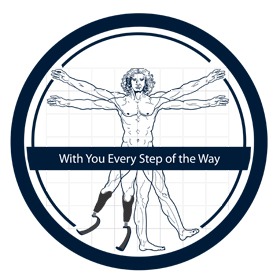At North Carolina Orthotics & Prosthetics, we treat the patient first, then address your prosthetic needs. Our relationship with patients often begins with wound care. We’ll work with your Physicians, Nurses, and Therapists and make every attempt to preserve your limb and its functions. We understand that limb loss can be one of the most challenging situations to face, physically, emotionally and financially. So we make it a point to take all the time necessary to listen to your concerns, answer your questions, and make sure you understand your treatment options. Even before an amputation takes place, we make ourselves available to patients and their doctors to assist and provide guidance on having a healthy and active life after surgery.
When it’s time to choose a prosthesis, we’ll guide you through each stage and explain your prosthetic device options. It can be overwhelming at first, but we’ll make sure you’re comfortable at every step in the process, which typically goes like this:
Consultation: At the request of your physician, we will meet with you prior to your surgery to discuss prosthetic options, outline a time frame for prosthetic visits, and even set up a meeting with an experienced amputee to discuss the road ahead. Many times, this is your first introduction to the field of prosthetics.
Examination: We’ll examine your residual limb, study your medical records and ask you about your work and leisure activity levels, as well as your goals. Our prosthetic evaluation follows Medicare’s Functional Classification Level, or K level, which is a standard method of defining a patient’s limb functioning needs. We’ll also contact your insurance provider on your behalf to determine if pre-authorization is necessary.
Recommendation: Based upon a patient’s functional level, job, hobbies, and insurance coverage, we can determine the best possible prosthesis to meet your needs.
Casting: A cast or custom measurements are taken of your limb in order to create a negative impression. This is turned into a mold that resembles your limb. We’ll then modify the mold to ensure that a patient’s limb can comfortably and structurally withstand your everyday activities.
Socket Fabrication: Using the mold of your residual limb, a diagnostic socket is fabricated out of a clear plastic. This allows us to see inside the socket for proper fit and total contact. Proper fit is critical to the prosthesis’ performance and your comfort. The plastic socket is also “thermo-moldable” in case changes are necessary to improve fit or comfort. Once a good fit is achieved, we’ll go back to our lab to add other components needed to complete the functioning prosthesis.
Final Delivery and Fitting: It’s time to fit you with your complete prosthesis. We’ll check its static and dynamic alignment to your body and its ability to function as needed. We’ll have you perform basic weight-shifting movements to assess your comfort and mobility level. This should also give you your first sense of achievement. We’ll then explain all of your prosthesis’ components and their purpose. We’ll provide you with complete instructions – both verbally and in writing — on how to care for and use your prosthesis. We’ll answer all of your questions and then set up future appointments. If necessary, a physical therapy program is also set up to continue your care program.
